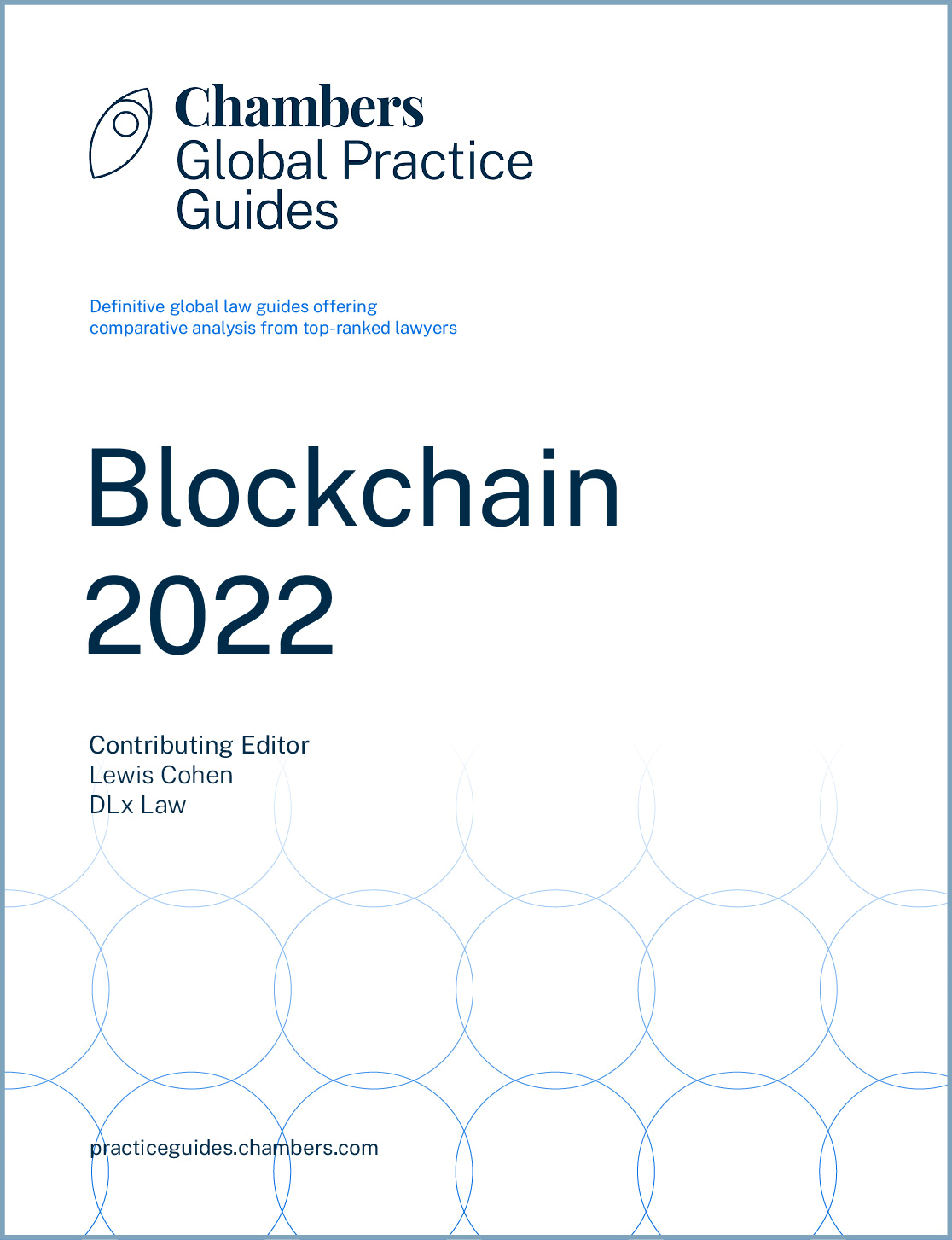
Blockchain 2022
The Blockchain 2022 guide features 20 jurisdictions. The guide provides the latest legal information on decentralised finance (DeFi), updates to tax systems to consider blockchain and cryptocurrencies, non-fungible tokens (NFTs), initial coin offerings (ICOs), smart contracts, data privacy and protection, and mining and staking.
Last Updated: June 16, 2022
Compare law and practice by selecting locations and topic(s)
Select Locations

Select Topic(s)

Please select at least one location and one topic to use the compare functionality.
Blockchain 2022 – an Overview
DLx Law is again pleased to introduce the Chambers guide to blockchain and cryptocurrency law and regulation. In the past two years, the guide has showcased the maturation of this nascent area of the law, highlighting the work of numerous jurisdictions in creating a regulatory environment in response to the rapid development brought by the disruptive technology of blockchain.
This year’s guide is an important step forward. In the past 12 months, the prices of bitcoin and many other digital assets reached all-time highs, followed by rapid downturns in the first few months of 2022. Nevertheless, both retail and institutional interest in the digital asset sector remain strong. One of the largest venture capital firms in the space – a16z crypto – recently raised a record USD4.5 billion fund at the time of the crypto market price collapse, which includes the downfall of TerraUSD, once one of the world’s largest stablecoins.
In fact, blockchain technology continued to be widely adopted across the globe in industries ranging from financial services (eg, payments, insurance, lending and asset management) to content-related businesses (such as art, music, videos and games). Areas of major development include the following.
Decentralised finance (DeFi)
The summer of 2020 became known as the “DeFi Summer”, and growth has continued in this area since then. According to certain reports, prior to the recent implosion of the Terra Protocol, total value locked in DeFi protocols peaked at close to USD256 billion (compared to USD90 billion in the previous year). Due to its nature of decentralisation, it has been difficult for regulators across jurisdictions to regulate truly decentralised products, except where they fall within existing regulatory frameworks.
Commentators from around the globe consider the development of DeFi in their jurisdictions in this year’s guide. In the United States, the Securities and Exchange Commission proposed to dramatically broaden the definition of “exchange” under the Securities Exchange Act of 1934, with the potential of scoping participants utilising decentralised exchange and automated market making protocols into the US regulatory perimeter.
Non-fungible tokens (NFTs)
A period of huge price appreciation for NFTs that were part of projects like “CryptoPunks” and “Bored Apes”, together with high trading volumes in these and other NFTs, led to what some referred to as the “NFT Summer” in 2021. The level of activity with respect to NFTs has been significant. In fact, NFTs have shown real staying power, with non-crypto native businesses around the globe finding creative ways to integrate these digital assets into their more traditional product offerings.
Non-profit organisations, such as universities, also started to explore the possibility of issuing NFTs to validate credentials. In addition to major use cases such as visual art, profile picture projects, collectibles and gaming, NFTs have also been used to promote social causes.
It is reported that total NFT transaction volume reached approximately USD25 billion in 2021. Notably, one NFT representing a digital artwork was sold for a record price of USD69 million. Nevertheless, we see from the guide that NFTs remain a new area across jurisdictions and, generally speaking, outside of any regulatory taxonomies.
Decentralised autonomous organisations (DAOs)
In the past year, DAOs have emerged as another key trend in the blockchain space. Generally, DAOs are managed by rules encoded in computer code, or smart contracts, built on blockchains. These smart contracts allow the DAO to automate organisational governance and decision-making and therefore operate with token holders’ input in a decentralised manner.
The DAO framework is still in its infancy in almost all jurisdictions. With only a tiny handful of exceptions (such as a framework put in place in the State of Wyoming in the US), there is no specific legislation to characterise DAOs as a new form of legal entity or to grant clear legal status to DAOs. In the last 12 to 18 months, the corporate form of a “foundation company” organised in the Cayman Islands has become popular for projects seeking a flexible governance structure to commence a DAO. As the sector matures, there will likely be further development on the structures and characteristics of DAOs, including potential legal wrappings for a DAO.
Developments on the regulatory framework
With the rapid expansion in digital assets came the inevitable regulatory push-back. From an enforcement perspective, there is likely to be more focus on each of the areas mentioned above, as use of these technologies continues to grow on a global scale. In addition, various jurisdictions paid close attention to regulating digital assets whose value is intended to be pegged to a second asset, known as stablecoins. Notably, the recent failure of the algorithmic stablecoin UST to hold its peg to the US Dollar (and the related collapse of associated asset Luna) highlights regulatory concerns in this area.
Using this year’s guide, experienced practitioners will undoubtedly gain valuable and actionable insights, while those new to the sector will benefit from the broad lateral survey provided as they begin their journey into this dynamic and evolving practice area. Below we look briefly at some of the representative developments on the regulatory frameworks you will find inside.
- In October 2021, the Financial Action Task Force (FATF – a multi-governmental organisation that sets global standards related to anti-money laundering) updated its guidance regarding virtual asset service providers (VASPs) to include an expansive definition of VASP, subjecting a variety of parties to compliance with anti-money laundering and counter-terrorism financing laws in jurisdictions that adopt this interpretation of the VASP definition. Concerned primarily with co-ordinating the global response to money laundering, financial crime and weapons proliferation, FATF’s guidelines were a stark reminder to practitioners that the area of blockchain is not a practice area for legal “tourists”: real liability can arise for market participants who are not au fait with all the latest regulatory developments in the space.
- The European Commission published regulatory proposals in 2020, including its proposed Regulation on Markets in Crypto-assets (MiCA), a proposed regulation on a pilot regime for market infrastructures based on distributed ledger technology and amendments to the existing framework of securities and investment laws, with the goal of regulating token issuances and crypto-asset service providers. As the most recent development of the legislative process, the European Parliament’s Committee on Economics and Monetary Affairs adopted a draft report on the MiCA in March 2022. The legislative process and negotiations continue among the European Parliament, the European Council and the European Commission.
- In Switzerland, the Federal Act on the Adaptation of Federal Law to Developments in Distributed Ledger Technology and the accompanying ordinance (DLT Bill) entered into force in 2021, amending existing federal laws in areas of securities, banking, financial services, insolvency, anti-money laundering and others. Among other things, the DLT Bill introduced a licence for DLT trading facilities, and improved the framework conditions for companies using blockchain in Switzerland through the introduction of book-entry securities on a blockchain.
- In early 2022, the President of the United States issued an Executive Order on Ensuring the Responsible Development of Digital Assets, addressing digital assets with the goal of establishing a comprehensive government approach to the space. The United States Congress has also introduced about 50 bills and resolutions with coverages including crypto taxation, central bank digital currency, regulatory treatment of digital assets and sanctions. Separately, the US Securities and Exchange Commission announced its plan to double the size of its enforcement team dedicated to policing securities law violations in the cryptocurrency market.
- In the Cayman Islands, the Virtual Asset (Service Providers) Act (VASP Act) came into force in October 2020, promoting the use of new technology and innovative enterprise in the Cayman Islands while complying with the FATF standards. The VASP Act also provides a framework for a technology-neutral regulatory sandbox that is expected to come into effect during 2022.
- In Korea, a series of amendments to the Specified Financial Information Act were implemented, setting forth VASPs’ obligations, such as reporting to the Korea Financial Intelligence Unit and anti-money laundering obligations, in order to comply with the FATF guidance and prevent criminal activities.
- In Singapore, amendments to the Payment Services Act have been passed (yet to become effective), which would widen the scope of regulated digital payment token services involving digital payment tokens and expand the powers of the Monetary Authority of Singapore (MAS) to impose additional licence conditions and user protection measures on service providers. The MAS has also proposed a Financial Services and Markets Bill for the financial sector that will regulate digital token services, to fully align itself with ongoing revisions to the FATF standards.
- In March 2022, the Financial Services Agency of Japan submitted a bill to amend the Payment Services Act and other laws to include a new regulatory framework for stablecoins, aimed at responding to the significant growth in the issuance and distribution of stablecoins overseas, and registration requirements, restrictions and supervision for electronic payment service operators and electronic payment instruments business operators.
Conclusion
In conclusion, the past year has been characterised by continuing engagement in, and wide adoption of, blockchain and digital asset technology in a variety of industries in jurisdictions around the world. As this guide ably demonstrates, for practitioners in almost every practice area, blockchain is no longer a technology that can be ignored or left for others to understand. As we see more legislative and regulatory focus drawn to this space, there is no doubt that the blockchain and digital asset sector will continue to mature and develop. Now let’s see what the coming year has in store!

